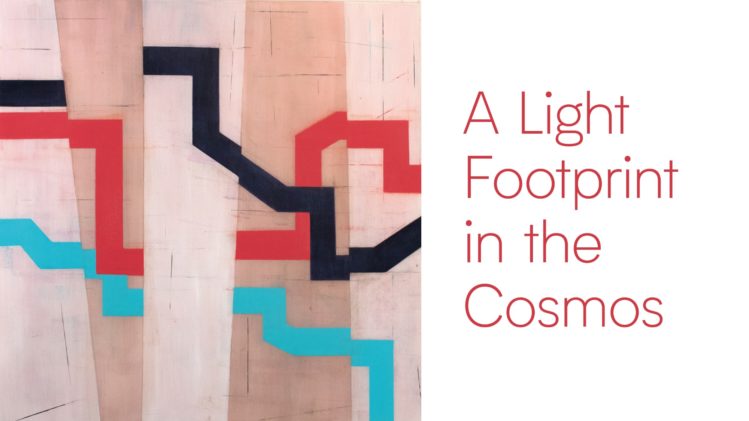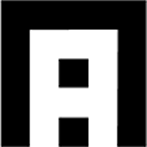
Image: Steven Baris, Never the Same Space Twice D29, 2022, oil on mylar, 24 x 24 inches.
A Light Footprint in the Cosmos
–
June 15 – 26, 2022
–
Current Gallery Hours:
Wednesday to Saturday, 12 PM – 6 PM*
*Subject to change as per COVID-19-related protocols. Face masks or face coverings are recommended during your visit.
–
Gallery Tour: Studio T, Centre A, and Or Gallery
Friday, June 24, 2022, 7:30 PM – 9 PM
With cash bar and refreshments
Extended Gallery Hours:
Sunday, June 26, 2022, 12 – 6 PM
–
A Light Footprint in the Cosmos is a celebration of research methods and intercultural dialogue elaborated by the Substantial Motion Research Network (SMRN).
Inspired by 17th–century Persian process philosopher Sadr al-Din al-Shirazi, Azadeh Emadi and Laura U. Marks founded SMRN in 2018 for scholars and practitioners interested in cross-cultural exploration of digital media, art, and philosophy.
A Light Footprint in the Cosmos features presentations by 60 scholars and artists, delivered both online and in person. The thought-provoking thematic threads include Grounding New Media in Traditional and Vernacular Technologies, Media Archaeologies, Travelling Cultures, Points-clés/Portals, Talismanic Media, Collective Imagination and the Imaginal, Cosmological Diagrams, I Ching as Method, Vibration and Breath, Body and Breath, Sensory Archaeologies, Healing Media, Algorithmic Media Disrupt Figurative Thought Patterns, and Three Ecologies.
The multi-site exhibition presents the works of 17 artists, curated by Nina Czegledy and hosted by Centre A, Or Gallery, and Studio T at Simon Fraser University’s Goldcorp Centre for the Arts. The artworks explore, via a wide variety of analogue and digital media, the global circulation and connectivity of theories and technologies, addressing both historical inspirations and contemporary issues. They illuminate hidden connections and reveal diverse yet complementary concepts and practices.
A Light Footprint in the Cosmos affirms the substantial movement of thought and practice by seeking to stage dialogues, provoke discussion and spark new collaborations in order to decolonize media studies, art history, and aesthetics.
Find out more about A Light Footprint in the Cosmos HERE.
–
Artworks Exhibiting at Centre A:
Steven Baris – Never the Same Space Twice (2018 – 2021), Oil on mylar, 24 x 24 inches
“I deploy an abstract geometric visual language to evoke what I describe as hybrid topological route maps and flow charts. These pieces map no specific or actual space, but rather they enact a virtual experience of negotiating indeterminate terrains marked by discontinuities, disruptions, and detours. A common thread connecting all facets of my art practice is my obsession with the challenges of spatial orientation and way-finding in our rapidly re-engineered, networked ecosystem. Topological mapping offers an apt mental schema to represent the discontinuity and fragmentation of contemporary spatial and temporal experience. With the series, Never the Same Space Twice, I deploy an abstract, geometric visual language to evoke what I describe as hybrid topological route maps and flow charts. These pieces map no specific or actual space, but rather they *enact* a virtual experience of negotiating indeterminate terrains marked by discontinuities, disruptions, and detours.”
Steven Baris was born in Aberdeen, Washington and grew up on multiple American Indian reservations in Northern California, Montana, and Washington State. He received a B.A. from The Evergreen State College in Olympia, Washington and an MFA from the Tyler School of Art in Philadelphia. He lives and teaches art in the Philadelphia area. He has exhibited widely throughout North America and Europe; his work is represented in New York by Kathryn Markel Fine Arts, in Philadelphia by the Pentimenti Gallery, and in Denver by Space Gallery. His work is included in numerous private, corporate, and public collections.
Navine G. Khan-Dossos – No Such Organisation (2018 – 2020), a series of watercolour works on paper, 100 x 100 cm
No Such Organisation is a series of works on paper that explore the ways in which recent developments in cyber spyware have compromised the safety and working conditions of journalists, activists and political dissidents throughout the world. Beginning with the death of Jamal Khashoggi, the series follows the development of this news story in real-time through the news articles written about the case as it happened. The works follow this narrative over months and branch out to cover wider issues raised by this case, predominantly the role of spyware such as NSO’s Pegasus program that has been sold to many governments.
Navine G. Khan-Dossos (b.1982 UK) has developed a form of geometric abstraction that merges the traditional Aniconism of Islamic art with the algorithmic nature of the interconnected world we live in. It is not abstract but informational in essence, suggesting that the way to ask questions about this subject is not to rely on and reproduce the figurative language of online media outlets, videos, and low-res stills, which shape our imagined versions of reality, but to invest in finding a new language that reflects the patterns and connections that underlie these images and generate them in the digital world.
Paul Goodfellow – Yeavering Bell II (2022), painting, 43 x 33 cm
The Yeavering Bell paintings are system-based works, which map colours sampled from Yeavering Bell in Northumberland. These painting exhibits the three forms of sign – index, icon, and symbol articulated by Charles Sanders Peirce, as they simultaneously share a material connection with the subject, describe the subject and symbolize the subject in the form of a diagram. These works form a dialogue with the work of the systems artist James Hugonin- who is based close to these hills.
Paul Goodfellow is an artist with an interest in the application of systems and processes in the understanding of nature and art. He has a particular interest in the application of systems within painting and the dialectical tension and divergence between the applied rules and the emergent paintings. With a background in environmental science and systems thinking, he is interested in the aesthetic and affective experience of information and the liminal spaces which emerge between the subject and its simulation in data.
Waèl el Allouche – Ways of Knowing: Materializing the Gaze (2017 – 2019), installation with 3D printed sculpture
Waèl el Allouche travelled to various places in Tunisia and Algeria. Starting from the west, he sought out places that have contributed to scientific knowledge within the west, while at the same time telling the story of his ancestors who fled from Algeria to Tunisia during colonization. The self-designed device is a means of measuring and capturing light to collect and display unknown perspectives and other ways of knowing. On the other hand, inspired by tourist journeys that took place from the 17th century under the guise of ‘The Grand Tour’, Waèl made a ‘Grand Retour’ with a non-linear journey through places of shared knowledge but with underexposed perspectives. This prompted reflections on what it is like when everything can only have an abstract form, like Islamic art. At the same time, light has always been there and creates the opportunity to return to a pre-colonization source in this part of North Africa. The coloured plaster casts represent the collected data in graphs, the bowls again, if you look from below and above, a panorama from the Al-Zaytuna Mosque where this light was measured.
Waèl el Allouche is an artist and designer and a graduate of the Ecole Nationale des Ponts et Chaussées (Paris), and the Gerrit Rietveld Academie (Amsterdam). He makes different perspectives comprehensible through unorthodox applications of data, and combines factual information with poetic and philosophical insights. He is interested in the way abstractions shape reality and vice versa through data and algorithms. By digitizing phenomena and objects from the world around him, he tries to understand them, before returning them to reality as reconstructions. He has exhibited work at Aeroscene Palais de Tokyo (Amsterdam), Het Nieuwe Instituut (Rotterdam), St. Tropez and WOW (Amsterdam).
Mansoor Behnam – Amalgams Fallen Through Earth’s Atmosphere (2022), video, colour, sound, 25 minutes
The video challenges the concepts of perception and thought to process through the fragmentation of pictorial space, and the destabilizing effect on the spectator. The video is a series of apparently irrelevant and random images, screenshots, recorded phone screens, short clips of objects, media reports, Tik Tok, Instagram, Facebook, email, chat screenshots, and marks while the voiceover directly refers to the idea of good and virtue while questioning and playing with religiosity and how it is reinforced through the use of linguistic means such as Dhikr and shath. Meaning “remembrance, mentioning, or reminder,” dhikr involves both the popular practice of this remembrance and mentioning the holy/sacred as well as the prayers, gestures, and postures used while enacting the remembrance. In the Sufi mystical tradition, shath is an ecstatic utterance that may be outrageous and nonsensical in character, because it is supposed to be caused by an overflowing or outpouring of senses leading to nonsense and self-expressive acts of dance and body movement (such as Sama dance and ritual, in Arabic meaning ‘listen to music.’ However, for the video, these tropes are used as performative and expressive elements modified into contemporary secular media products to communicate good and virtues that are to facilitate contemporary communal life. The voice-over will be in Arabic, while other languages such as Farsi and English will be used as subtitles or intertitles. Utilizing these concepts, the video experiments with contradictions–how mystical can it be to reconcile the opposing forces of language/image and perception?
Mansoor Behnam is an interdisciplinary and intercultural media maker, writer and scholar in the fields of Comparative Literature, Iranian Cinema, Global Film/Media, and Cultural Studies. However, his research and practice are usually informed by the comparison between Islamic thought/mysticism and Gilles Deleuze’s philosophy of Immanence to investigate the intertwined mystical relationship between philosophy, cinema, technology, and the everyday life of a human subject. He, therefore, uses both Eastern and Western media technologies such as alphabets and pictures; Islamic philosophical/mystical concepts to rejuvenate sensations archived/embodied in objects and images which lead to different forms of affects. This opens a layer of sensationalism that allows for wholistic adjustments/manipulation of the mass media consumers that is a problematic and always-questionable space. Behnam’s work has been screened and discussed in film festivals, artist-run centres, and universities.
_
About the Curator:
Nina Czegledy is an independent curator, media artist, researcher, and educator based in Toronto, Canada. She collaborates internationally on art & science & technology projects. Current curatorial projects: A Light Footprint in the Cosmos for the Substantial Motion Research Network (2022) in Vancouver, and Sensoria, the art and science of our senses Laznia, Contemporary Art Centre Poland in collaboration with Sensorium Centre for Digital Arts and Technology, Canada (2022), Dobble Debate educational game focused on dis/different abilities with Lynne Heller (2022). Recent curatorial projects: Agents for Change/ Facing the Anthropocene (2020), The Museum, Canada; Who is you? (2019), JD Reid Gallery, New Zealand, Leonardo 50th, CyberArts ARS Electronica (2018), Austria.
Accessibility: The gallery is wheelchair and walker accessible. If you have specific accessibility needs, please contact us at (604) 683-8326 or [email protected].
Centre A is situated on the unceded territories of the Musqueam, Squamish, and Tsleil-Waututh peoples. We honour, respect, and give thanks to our hosts.









